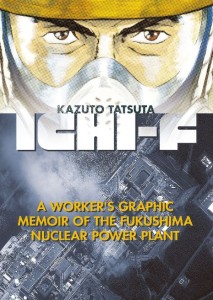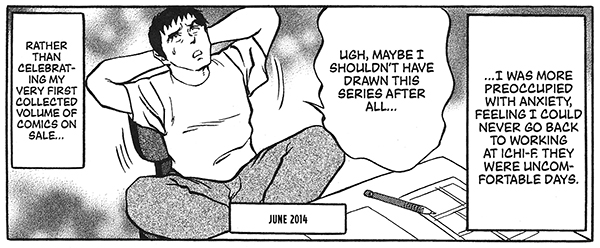 ”There’s no room for nerves or pathos when the car is full of raucous laughter.”
”There’s no room for nerves or pathos when the car is full of raucous laughter.”
Creative Staff:
Story & Art: Kazuto Tatsuta
Translation: Stephen Paul
Retouching: James Dashiell
Lettering: AndWorld Design
Editing: Lauren Scanlan
Editorial Assistance: Ben Applegate
What They Say:
On March 11, 2011, Japan suffered the largest earthquake in its modern history. The 9.0-magnitude quake threw up a devastating tsunami that wiped away entire towns, and caused, in the months afterward, three nuclear meltdowns at the Fukushima Daiichi Nuclear Plant. Altogether, it was the costliest natural disaster in human history.
This is not the story of that disaster.
This is the story of a man who took a job. Kazuto Tatsuta was an amateur artist who signed onto the dangerous task of cleaning up the Fukushima Daiichi Nuclear Plant, which the workers came to call “Ichi-F.” This is the story of that challenging work, of the trials faced by the local citizens, and of the unique camaraderie that built up between the mostly blue-collar workers who had to face the devious and invisible threat of radiation on a daily basis. After six months, Tatsuta’s body had absorbed the maximum annual dose of radiation allowed by regulations, and he was forced to take a break from the work crew, giving him the time to create this unprecedented, unauthorized, award-winning view of daily life at Fukushima Daiichi.
“I drew this manga because I wanted people to see what day-to-day life at the nuclear power plant is like. Because I believe that’s essential to the future of our country.”
-Kazuto Tatsuta
The Review:
Content: (please note that content portions of a review may contain spoilers)
In a time of hyper-awareness, oddly enough it’s become that much more difficult to actually empathize with others during times of disaster. The earthquake and subsequent tsunami that devastated Japan in March 2011 affected so many lives and left so many uprooted from their homes that you can’t help but feel immediate sadness at the very real and unfortunate situations that said victims must now face. But at the same time, to immediately stamp the label of “victim” onto those people takes away a certain level of humanity from them. It becomes easier for outsiders-looking-in to digest such an awful turn of events when elements of drama—victimizing a person while ignoring all other aspects of their reality—are thrown into the mix. And while such may not be inherently bad, it does go out of its way to oversimplify a problem much more complex than simply “I am sad because this bad thing happened to me.”
And while the narrative in Ichi-F does have its fair share of other flaws, it’s safe to say that the aforementioned victimization of those affected by the tsunami is not one of them.
At its best, Ichi-Fis able to take the lives of those currently working in the Fukushima Daiichi Nuclear Power Plant and turns them into regular, daily occurrences of working class people. Author Kazuto Tatsuta is able to take his experiences working in the power plant and tell them in such a matter-of-fact way, always making sure never to cross the line into trivializing the natural disaster, while still fully committing to a worthwhile opinion himself. Issues such as having an itch while covered in layers of anti-radiation clothing are comical and minor, yet speak volumes as to how he feels about addressing the Japanese people most affected by the earthquake. He never paints them as objects to be pitied, but people to be treated normally because that’s what they are.
My only complaint is that said moments of interactions with locals and commentary on media overreactions are so few and far between. Totaling at 500+ pages, Tatsuta spends much more time focusing on his life as a subcontractor, working his way through training, paperwork, and the arduous process involved in his daily grind at Ichi-F. At first, his overly long explanations of applying layered clothing (you’ll soon become far too familiar with the term “Tyvek”), face masks, and driving routes to the plant come off as quirky and informative, but as the chapters continue and the daily grind gets same-y, so do his chapters. Walls of exposition end up reading more like a textbook with an equivalent amount of allure.
However, at best, these chapters depicting the struggle of an outsider wanting to find work in a place people tend to turn a blind eye to provide a different form of allure—removed from the context of the earthquake, tsunami, and power plant altogether. Seeing Tatsuta struggle to make ends meet, forming unlikely relationships while learning the ropes in a field of work entirely new to him gives off a very seinen feel reminiscent of something you’d see out of the Space Brothers manga, and his level of commitment to the job at hand is equal parts commendable and naïve.
Getting into the technical aspects of this release, I will say Kodansha has taken an odd decision in terms of presenting the manga. Unlike the majority of manga published in English today, Ichi-F has been flipped to read left-to-right instead of its native right-to-left. However, because some of the text makes explicit mention of directions on maps and the like, certain panels remain in their original “unflipped” format. This Frankenstein mishmash of panels results in some oddball reading flow that while is admirable to have sifted through, could have been avoided entirely had the manga simply been presented as a manga in the first place. The inclusion of an exclusive interview and drawing from the author himself at the end of the release is an appreciated bonus, but as a whole only makes the flipped nature of the manga that much more curious.
In Summary:
At its best, Ichi-F effectively humanizes the people most affected by a natural disaster without coming off as insensitive. His personal anecdotes make the 2011 disaster itself feel that much more real and immediate without playing up the victim aspect simply for drama’s sake. It’s in Tatsuta’s very straightforward style of narrating that the manga’s greatest strengths, as well as weaknesses, are formed, but perhaps that was the point all along.
Content Grade: B
Art Grade: B+
Packaging Grade: C+
Text/Translation Grade: A
Age Rating: 13+
Released By: Kodansha Comics
Release Date: March 7, 2017
MSRP: $24.99





